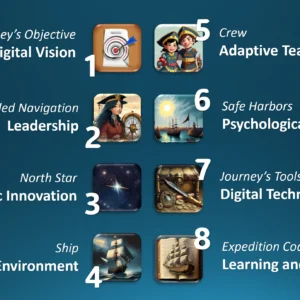In today’s rapidly evolving digital world, measuring and cultivating an organization’s openness to change is crucial for managing and guiding growth. It is an essential asset that organizations need to develop to thrive in dynamic environments.
This article will explore a step-by-step approach using the Chameleon Matrix as a valuable tool.

The asset “Being Open to Change” is important not only for Digital Transformation but also for being innovative and efficient:
- Innovation: When a company is open to change, it’s more likely to try new things and experiment.
- Efficiency: Changes often involve new technologies or processes that increase efficiency. Being open to change can allow a company to improve productivity, reduce costs, and deliver better customer value.
Chameleon Matrix
To assist organizations in navigating their transformation journeys and embracing change, I have developed a tool called the “Chameleon Matrix.”
This tool breaks down the organization into four distinct areas, each representing a different aspect of the organization’s willingness to embrace change.
The goal of the matrix is to simplify the complex dynamics within the organization, enabling leaders to gain clear insights and devise effective strategies for managing change. The Chameleon Matrix serves as a visual representation, facilitating an understanding of the organization’s openness to change and guiding leaders in making informed decisions throughout the transformation process.
Chameleon Matrix instructions:
- Identify problems and grassroots: Add cards to each area of the matrix.
- Evaluate possible concrete actions: For each card, derive actions that cultivate the organization’s openness to change.
- Execute prioritized actions: Rank the actions based on their impact and the effort required.

Area 1: “Resistance to Change”
This area encompasses situations within the company where there is a reluctance or inability to embrace change due to certain beliefs or hypotheses that may lack factual evidence.

Cards examples:
- Some employees resist change due to a fear of disruption or uncertainty.
- Certain teams or departments are skeptical about the benefits of proposed changes.
- Managers adhere to traditional practices and are hesitant to explore new approaches.
Actions examples:
- Challenge existing beliefs and hypotheses by presenting data and evidence that support the proposed changes.
- Provide comprehensive education and training to address misconceptions and increase understanding of the benefits of change.
- Promote open and transparent communication to reassure individuals and create a safe environment for expressing concerns and addressing resistance.
Area 2: “Willingness to Change”
This area represents instances within the company where there is a willingness to try new things and embrace change based on certain beliefs or hypotheses.

Cards examples:
- Employees eagerly participate in pilot projects to test innovative solutions.
- Teams actively seek out opportunities for process improvement and optimization.
- Department heads willingly explore new strategies to adapt to market trends.
Actions examples:
- Provide dedicated resources, such as time, budget, and tools, to support experimentation and implementation of new ideas.
- Offer training programs and workshops to enhance employees’ skills and knowledge in areas relevant to the proposed changes.
- Establish recognition programs to acknowledge and reward individuals or teams who proactively embrace change and achieve positive outcomes.
Area 3: “Learn from Failure”
This area comprises situations where resistance or failure to change is rooted in past unsuccessful attempts, leading to a negative reputation for new changes.

Cards examples:
- The organization has a history of unsuccessful implementation of new technologies.
- Failed projects have resulted in a reluctance to embrace change due to fear of repeating past mistakes.
Actions examples:
- Thoroughly analyze the reasons behind past failures to gain a comprehensive understanding of what went wrong.
- Extract valuable lessons from previous failures and incorporate them into future change initiatives.
- Implement robust change management practices, such as thorough planning, clear communication, and regular evaluation, to avoid repeating past mistakes and increase the chances of success.
Area 4: “Success Stories”
This area represents success stories within the company where individuals or teams have successfully implemented change, resulting in significant growth or improved efficiency.

Cards examples:
- A team successfully introduced a new process that streamlined operations and improved productivity.
- An individual implemented a new technology solution that enhanced customer satisfaction and sales.
- The organization implemented a strategic initiative that resulted in substantial revenue growth.
Actions examples:
- Celebrate and showcase these success stories within the organization to inspire and motivate others.
- Recognize and reward the individuals or teams responsible for driving successful change initiatives.
- Encourage knowledge sharing and learning from these experiences to promote a culture of continuous improvement and innovation.










